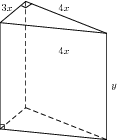| << Chapter < Page | Chapter >> Page > |
We have seen that differential calculus can be used to determine the stationary points of functions, in order to sketch their graphs. However, determining stationary points also lends itself to the solution of problems that require some variable to be optimised .
For example, if fuel used by a car is defined by:
where is the travelling speed, what is the most economical speed (that means the speed that uses the least fuel)?
If we draw the graph of this function we find that the graph has a minimum. The speed at the minimum would then give the most economical speed.

We have seen that the coordinates of the turning point can be calculated by differentiating the function and finding the -coordinate (speed in the case of the example) for which the derivative is 0.
Differentiating [link] , we get: If we set we can calculate the speed that corresponds to the turning point.
This means that the most economical speed is 80 km hr .
Video on calculus - 4
The sum of two positive numbers is 10. One of the numbers is multiplied by the square of the other. If each number is greater than 0, find the numbers that make this product a maximum.
Let the two numbers be and . Then we have:
We are required to minimise the product of and . Call the product . Then:
We can solve for from [link] to get:
Substitute this into [link] to write in terms of only.
The derivative of [link] is:
Set to find the value of which makes a maximum.
Substitute into [link] to solve for the width.
The product is maximised if and are both equal to 5.
Michael wants to start a vegetable garden, which he decides to fence off in the shape of a rectangle from the rest of the garden. Michael only has 160 m of fencing, so he decides to use a wall as one border of the vegetable garden. Calculate the width and length of the garden that corresponds to largest possible area that Michael can fence off.

The important pieces of information given are related to the area and modified perimeter of the garden. We know that the area of the garden is: We are also told that the fence covers only 3 sides and the three sides should add up to 160 m. This can be written as:
However, we can use [link] to write in terms of : Substitute [link] into [link] to get:
Since we are interested in maximising the area, we differentiate [link] to get:
To find the stationary point, we set and solve for the value of that maximises the area.
Substitute into [link] to solve for the width.
A width of 80 m and a length of 40 m will yield the maximal area fenced off.



Notification Switch
Would you like to follow the 'Siyavula textbooks: grade 12 maths' conversation and receive update notifications?